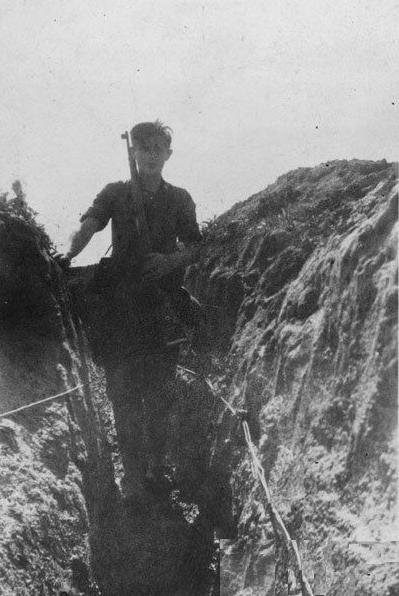
World War II German Trops: Inexperienced Young Recruits

Figure 1.--This German snapshot shows a young German soldier in a trench somewhere in the East during 1942. Hitler's 1942 summer offensive because of the losses in the winter of 1941-42 was dependent on the performance of the 1942 18-year old induction class. On their backs the fortunes of the NAZI rehime would rise or fall.
|
|
One of the several weaknesses of Operation Blue, the German Summer offensive into the Caucasus, was the large number of young, inexperienced troops from the 1942 18-year old induction class. Hitler was well aware of this, he told his generals, "The operation must begin with success; young troops mustn't suffer any setbacks. Young troops need special support. The operation must proceed in such a way that our young divisions get used to the enemy." (March 28, 1942). [Hadler, p. 3:420.] They did not, however get that special support. There were early victories, but then the battle focused on Stalingrad. And older soldiers, especially in Stalingrad, remarked that the new recruits lacked the needed toughness. Young, inexperienced troops do not necessarily lack toughness. One of the toughest fighting German divisions of the War was the inexperienced 12th SS Panzer Division which by the fortunes of war was deployed south of Normandy after it was created. The division fought around Caen after D-Day. It was a Waffen-SS division composed largely of 18-year old Hitler Youth boys with veterans for the officers and NCOs. The difference here was that they were not conscripts, but ardent NAZIs that had volunteered an anxious to fight. And they prevented Montgomery from taking Caen which he was supposed to do on the first day of the invasion. Although outnumbered, they fought off a series of British and Canadian attacks. The 12th Hitler Youth Division, however, was decimated in the process. Only a handful of the boys made it back to the Reich. In the last months if the War, ironically it was the younger soldiers, often 18-years old or younger that were most willing to fight. Most of the older soldiers, with the exception of the Waffen-SS, were more willing to surrender as long as they could do so to the Western Allies.
Sources
Hadler, Franz. March 28 entry, Kriegstagebuck. Vol. III: Der Russlandfeldzug bis zum Marsch auf Stalingrad" ((Stuttgart: W. Kohlhammer Verlag, 1964).
HBC

Navigate the Boys' Historical Clothing Web Site:
[Return to Main Operation Blue 18-year old class page]
[Return to Main World War II German conscription page]
[Return to Main Operation Blue page]
[Return to Main World War II age page]
[Return to World War II turning point page]
[Biographies]
[Campaigns]
[Children]
[Countries]
[Deciding factors]
[Diplomacy]
[Geo-political crisis]
[Economics]
[Home front]
[Intelligence]
[POWs]
[Resistance]
[Race]
[Refugees]
[Technology]
[Bibliographies]
[Contributions]
[FAQs]
[Images]
[Links]
[Registration]
[Tools]
[Return to Main World War II page]
[Return to Main war essay page]
Created: 9:22 AM 12/31/2010
Spell checked: 12:47 AM 11/3/2013
Last updated: 12:47 AM 11/3/2013



